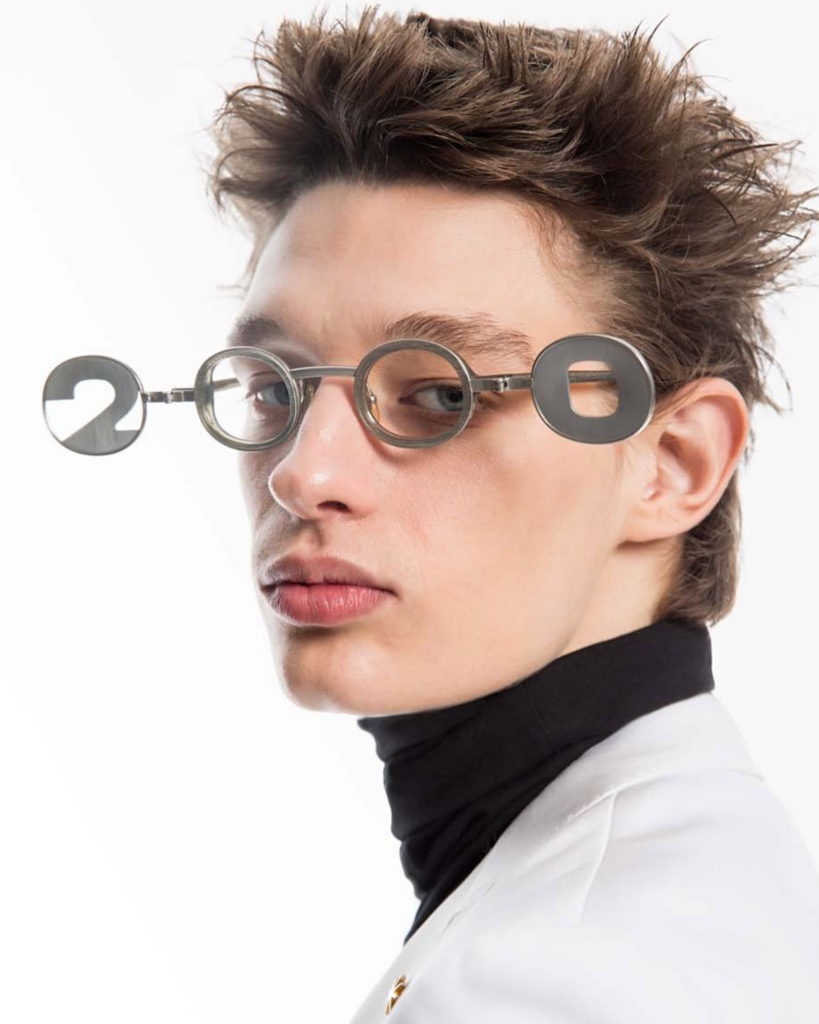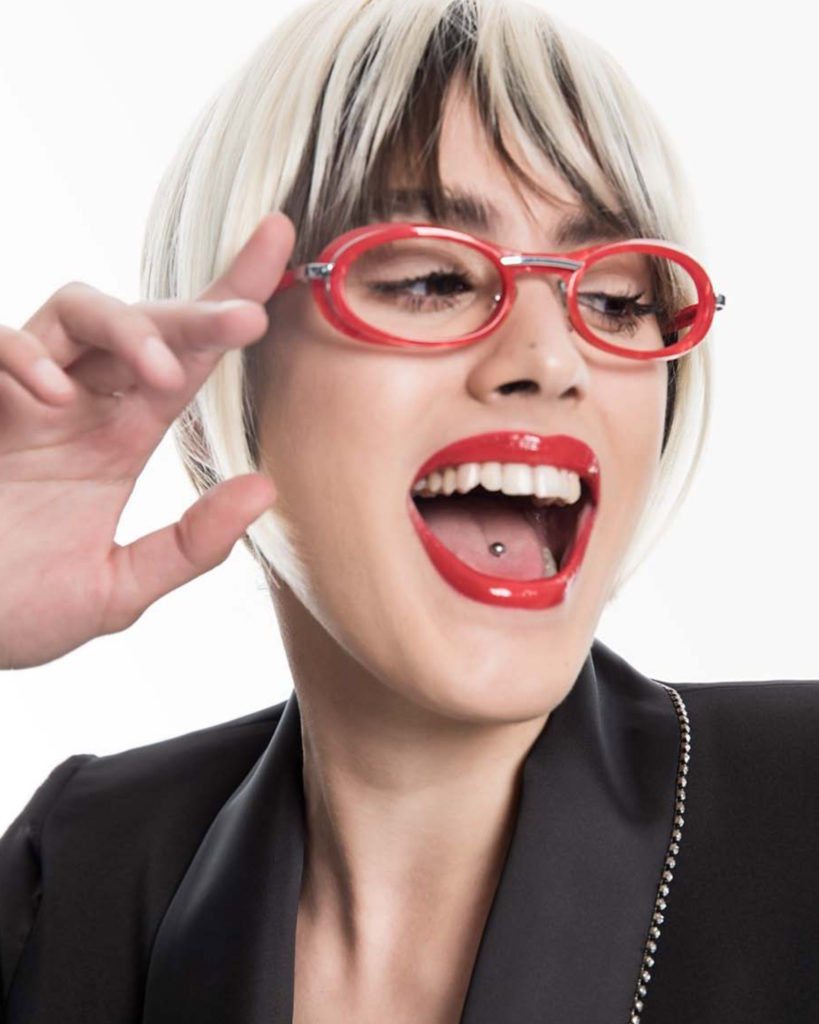Alain Mikli: Dressing the eyes to pay homage to the soul
In a past interview he declared that having a big nose drove him to find a way to hide it using glasses … We ask the famous designer of ‘lunettes’ Alain Mikli if that is how it went. “No, but it is true. I am lucky to have a nose, it is a family heirloom. But I do not try to hide it, on the contrary it is very useful and fulfills many functions”.
More seriously, how did your career path lead you into the world of eyewear?
My path was guided by chance: a chain of events led me to study to become an optician and in the end I became an eyewear designer. Life sometimes does things very well, especially when you are innocent or oblivious and lack of self-confidence. At 14 it is very difficult to choose a professional career (in France we are asked to decide about our future pretty soon). What really matters more than anything else, I believe, is putting a lot of passion into what life offers or proposes, always trying to be the best at what you do”.
What did Alain Miklitarian dream of doing as a child?
“As a child I dreamed of being a forest ranger, so that I could enjoy long naps under the trees, away from people’s gaze. Unfortunately, I had to attach my latest school report to my enrollment request, and they turned me down. I wasn’t a good enough math student. It’s incredibile that at the time I didn’t realise that maths was important to be able to afford a nap under the trees. It was then when I enrolled in a professional institute of mechanics where I took the industrial optics course to make telescopes, until I ended up in the class I was prepared for the profession of optometrist”.


What cultural influences weighed on your training as a man and designer?
“Being my parents of Armenian descent, their native culture has unknowingly influenced me throughout my life. Roots are still deeply embedded in me. Being Armenian, in today’s world, means being free to feel like universal citizens, to be at the service of humanity without borders and without restrictions of thought. Being Armenian means enjoying the pleasure of receiving, living and loving. It means knowing how to enjoy friendship, peace, respect, elegant provocations, independence, sharing, cooking. Values that we know how to appreciate because on many occasions many have tried to take them away from us. Values that are found in my work and in my creations through a great diversity of shapes and colours. Each individual is characterised by his DNA which contains his entire, unique and unrepeatable history and his/her glasses must only respect this unicum. I never wanted those who choose my glasses to find themselves wearing a universal mask and for them to have the illusion of belonging to the fashion tribe. It would be like hiding behind an impersonal and standardised image”.
You have never talked very favourably about fashion. How come?
“Fashion does not exist to respect the consumer, but to exploit him, to empty his wallet making him believe that he will be the most beautiful and the most intelligent. To be direct: this way of thinking is absolutely contrary to mine and, to tell you the truth, I don’t think I would be able to achieve my best possible design and be trendy every season. Sometimes some of my creations have become cult fashion items. I assure you that it was neither a sought nor a desired result, but a mishap that happened to my enormous surprise”.
Which concepts and which aesthetic philosophy guide the creation of a new piece?
“I am obsessed with the concept of freedom: not wanting to belong to a clan where each individual loses his/her soul to look like other people. What is more beautiful than reading the soul of a person on a person’s face through the imprint of time or youth, or even the accidents of life? Why hide all this richness behind an ornament that conveys anonymous fashion codes? A philosophy that allowed me to move from simple round glasses to asymmetrical triangular glasses or shutters on the eyes”.


If the eyes are the mirror of the soul, how important is it for you to “dress” them with your creations?
“Dressing the eyes, which represent a direct link to the soul, means taking part in the fascinating game with oneself and with others. You can highlight some traits of your character or, on the contrary, remain mysterious by hiding them. What could be more beautiful than feeling such self-confidence in order to allow yourself to constantly play with the thousand and one facets of your soul. Hence the green light for a great diversification of shapes and colours”.
Where do you find inspiration for your never trivial proposals?
“The inspirations spring from the eyes of all the unknown people I met in the four corners of the world. My lifestyle leads me to observe everything around me, to read faces, to observe gazes. This human richness obviously guided me in my creations. The beauty of the expression of a face lies in the subtle imperfection, the right side of our face is completely different from the left, without this affecting or disturbing us, on the contrary it is this imbalance that fuels our charm. When today a car is designed, it is imagined and built with the utmost precision and in perfect symmetry. How sad and trivial it is that there is no more room for emotion in a world that demands perfection”.
Could you tell us the story of how your first glasses were created?
“I was very shy and didn’t know how to draw, my first pair of glasses was insignificant and without any personality, it looked like any pair of glasses. They show the full extent of my creative talent. Fortunately, I didn’t study design and at first I didn’t understand the meaning of my life”.
Do you like being also an entrepreneur beyond just being creative?
“Yes, the two aspects are highly interconnected, you have to focus on creating and you need to create to develop business. In my case, in the first place, I want to be a good entrepreneur, to be able to finance innovation. For example, to launch Starck’s Biolink model (eyeglasses and sunglasses featuring a screwless-hinge based on the model of the human clavicle, that affords the stem full 360-degree movement. A jewel of biomechanics applied to fashion design and to the world of optics, ed). We had to invest huge sums of money to successfully develop and commercialise an innovation, which allowed us to create very different eyewear compared to the past”.
Any curious anecdote on a famous client of yours?
“Without mentioning any names, I can tell about a pair of glasses that I believe have become the most expensive in the world. A unique creation for a unique celebrity. We were late in the production of this unique piece in our Parisian workshop. The glasses would then have to fly very far to be delivered the same day. Our client therefore decided to stop a plane and all its passengers for several hours, and thus give us time to finish the manufacturing. I never dared to calculate the final expense for that pair, considering the price of our work and the additional cost of stopping a plane with over 300 people on board”.
Many famous people have shown off your glasses. Who impressed you the most?
“They all have one thing in common: they all paid for my glasses to become even more famous. And I’ve never used their image to do business. It gave me much more satisfaction to meet an illustrious stranger on the street wearing one of my creations. I don’t see why I should always have to call a celebrity to convey a messagge”.
I’m a huge fan of Elton John. What has he meant to you as a person and in your career?
“Elton is carefree and generous, he knows what it means to show off and at the same time think about the future. One day he made us close our optics shop in rue des Rosiers to be able to admire and choose in peace. I think that day he bought about 80 frames with the addition of corrective lenses. As we had gone well beyond the agreed time, he left us his credit card to reach out to us. He is a gentleman who matches kindness to talent, I can’t say the same of anyone else I ever met”.
You have been dealing with sight all your life… in recent years you have worked hard even for those who do not have this gift.
“I have been involved in projects that make the art and beauty of the world available to people with visual disabilities for about 30 years. Sight has given me so much, it seems right to help in some way even those who have not had as much luck in that respect”.
Technological innovation now affects all sectors. Do you embrace it or do you prefer to rely on tradition?
“Tradition is right to look at the past, but it is necessary to imagine an innovative future. It is innovation that guides our lives towards tomorrow and we will have to continue to conquer the universe, always pushing the limits of infinity a little further. On the other hand, short-term innovation is dangerous for a company. It is very expensive and it is very complicated to collect the profits”.
What does Alain Miklitarian do when he doesn’t think about glasses?
“Not much, I at last take the time to go out, make jams, cook for family and friends, I enjoy gardening, sneaking around without breaking a sweat. I love taking a ride in one of my old cars, discovering places right next to my house, places I have ignored for so many years. I am fortunate to have a home in Corsica and I allow myself to embark on the ancient journey from Paris to Toulon where my boat is moored. It’s a 24-hour travel journey if all goes well, while it only would take 3 hours by plane. I consider it a luxury to spend time like this, just for the fun of it”.
What are you waiting for?
Fill the form to read AFMAG #20 for free
